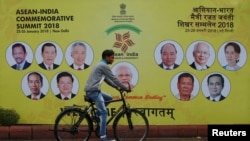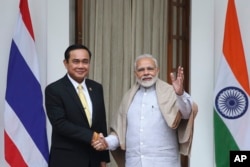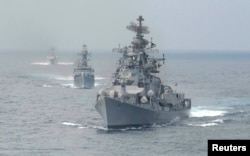With an eye on China, Indian Prime Minister Narendra Modi and leaders of southeast Asian nations agreed during a summit in New Delhi to strengthen maritime ties.
"India shares ASEAN's vision for peace and prosperity through a rules-based order for the oceans and seas," Modi said Thursday, as he spoke to the 10-member Association of Southeast Asian Nations.
Calling for greater security cooperation with ASEAN, he emphasized that freedom of navigation will be a key focus.
The summit comes a day before India's annual Republic Day parade, to which all 10 leaders of ASEAN countries have been invited. The event marks the first time that New Delhi is hosting such a large group of foreign leaders at the annual parade that showcases its military strength.
New Delhi's outreach signals that both sides want to expand the relationship to balance out China's growing assertiveness and dominance of the region, according to observers.
Maritime cooperation also was a key focus at a series of bilateral meetings Modi held with the southeast Asian leaders, according to Preeti Saran, an official in the Indian Foreign Ministry. Without elaborating, she said they addressed "both traditional and non-traditional challenges all of us face collectively."
Several countries at Thursday's summit are locked in territorial disputes with China — India in the high Himalayas, and southeast Asian countries like Vietnam in the South China Sea. Observers say China's aggressive stance in these disputes is prompting India and ASEAN to reach out to each other.
Beijing has expanded its coast guard and military presence in the South China Sea, a 3.5-million-square kilometer tract of water rich in fisheries and fuel reserves. Claims by Brunei, Malaysia, Vietnam and the Philippines overlap with those of China, which calls nearly the whole sea its own.
China began to expand in the sea in 2010 by reclaiming land to build artificial islands, some apparently for military use. It's ready to deploy radar systems and fighter jets on some, according to the Asia Maritime Transparency Initiative under American think tank Center for Strategic and International Studies.
"I think it has taken a strategic dimension now and India wants a larger footprint in southeast Asia," said Harsh Pant, with New Delhi's Observer Research Foundation. "The rise of China is in many ways creating issues for both India and ASEAN."
Southeast Asian countries also worry about whether they can continue to rely on the United States for their security, according to Pant. "There is a perception in the region that America might be retreating, that America is unwilling to hold up to its role as security guarantor. That balance is changing at some level. It is in this context that they have reached out to countries like India also."
India already has strong naval ties with countries such as Singapore, Vietnam, Indonesia, Thailand and Malaysia. In the past three years, Indian naval ships have visited ports in several of these countries, and joint naval exercises in the Malacca Straits may occur in the near future.
New Delhi also has been deepening military cooperation with some countries, including Vietnam.
At the summit, Modi emphasized growing economic ties with the region — India's trade with the ASEAN countries has been increasing, but is considered far below potential and is dwarfed by that of China.












